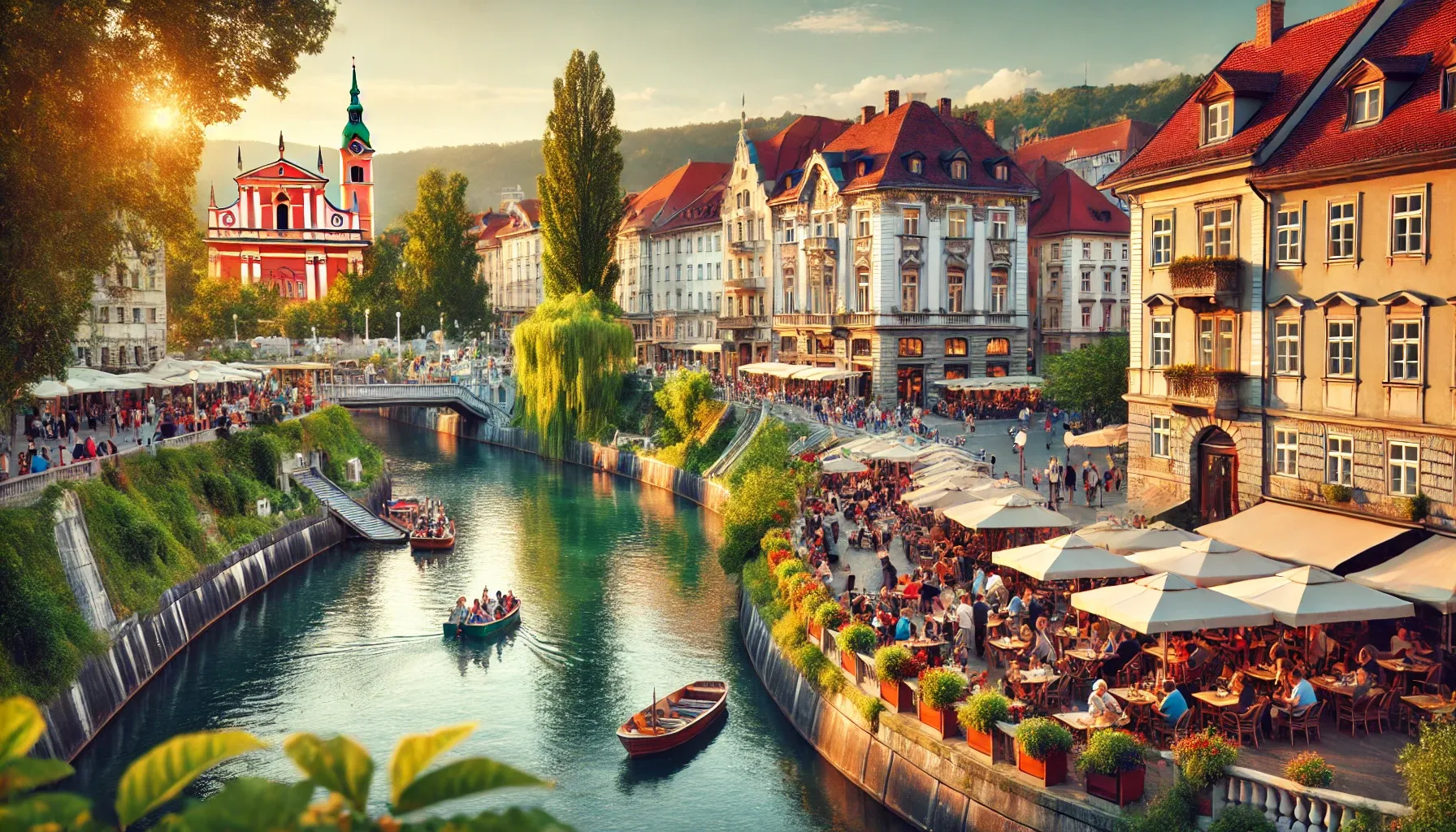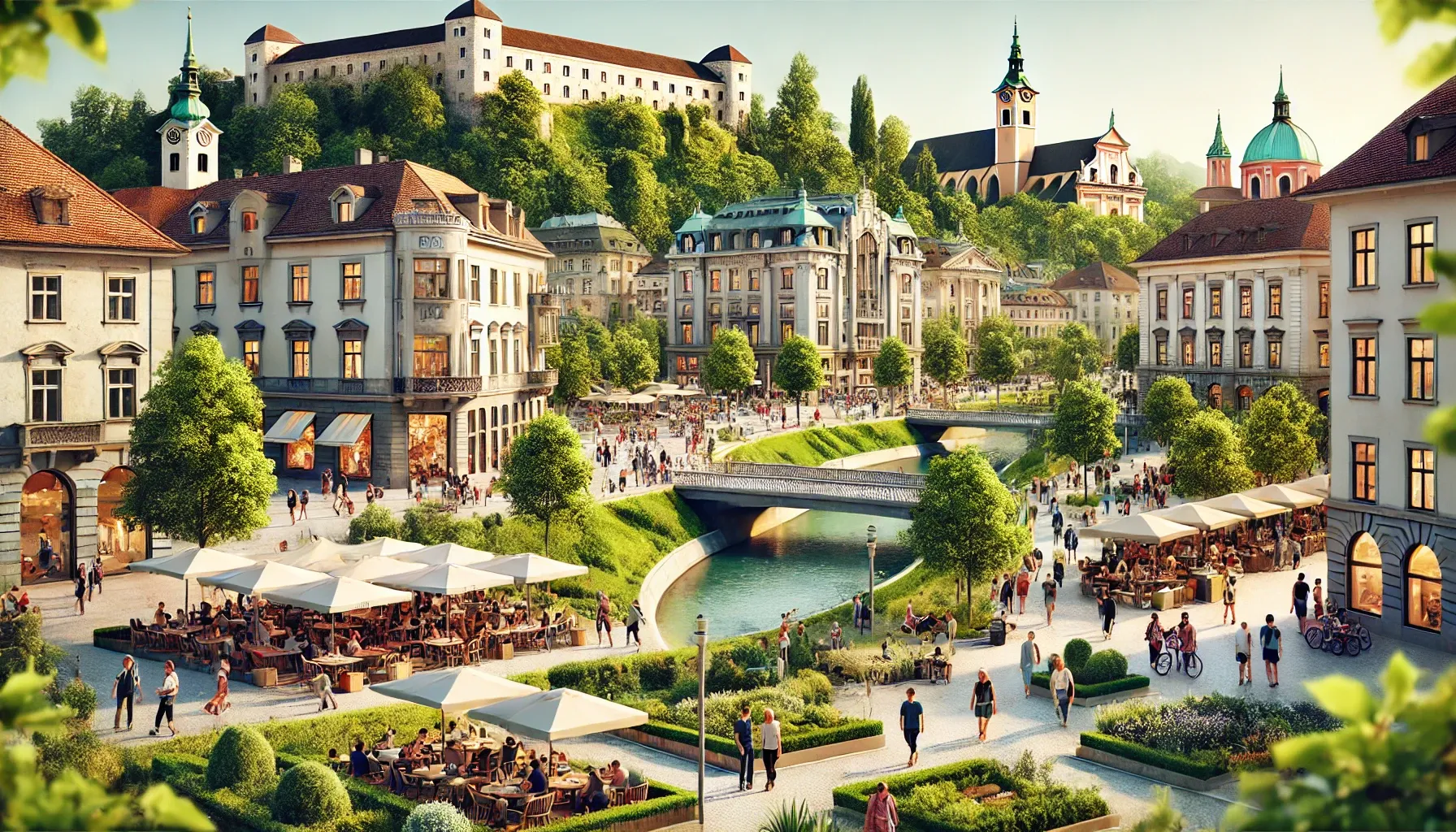Why is Ljubljana becoming a center of culture and an attractive tourist destination?

- Why you should visit Ljubljana: historical and architectural heritage
- Ljubljana: cultural heritage or a modern city to live in?
- Trends in the real estate market in Slovenia: what investors need to know?
General overview of Ljubljana
The capital of Slovenia is the city of Ljubljana, which is located in the center of the state. This city, rich in history, has more than 250,000 inhabitants, among whom about 50,000 are students. Ljubljana is divided into 17 districts.
The first mention of this settlement dates back to the 1st century, when it was called Emona. Throughout its long history, the city has changed its names: Luvigana, Laibach, and only in 1918 did it receive the name Ljubljana.
This settlement occupies a strategically important position on the trade route connecting the Danube region and the northern part of the Adriatic Sea. Furthermore, in the past, it was the center of the historical region of Krajina, which was part of Austria-Hungary and had a significant Slovenian population. Since Slovenia gained independence in 1991, the capital has been designated as the cultural, educational, and political center of the country.
Nature and infrastructure
Ljubljana is spread along the picturesque Ljubljanica River, with seven other rivers and an extensive system of artificial canals designed to prevent flooding. The city has a rich historical heritage spanning more than five thousand years.
The traces of ancient Roman Emona can be seen in the historical center, where there are:
- medieval castle
- baroque architecture
- exquisite portals
- characteristic roofs
The modern cityscape is organically complemented by picturesque bridges crossing the Ljubljanica River, as well as the unique Tivoli Park, located northwest of the city center.
A trip to Ljubljana
There is only one direct flight from Moscow to Ljubljana, which is operated by Adria Airways, departing from Moscow's Sheremetyevo Airport. Travel time is just over three hours, and round-trip ticket prices start at approx.12,000 rubles.
The airport is located 27 kilometers from the city, it offers regular bus services, the cost of the trip is4.10 eurosThe duration of the route is about 50 minutes. Shuttle taxis are also available for...9 euroswith a travel time of about 30 minutes.
A cab from the airport will cost30-40 eurosAdditionally, the Airtrail service offers a fixed taxi fare of20 eurosHowever, a preliminary reservation is mandatory.
Road trip
If you prefer to travel by personal car, keep in mind that the journey from Moscow to Ljubljana will take more than 24 hours, as the distance between the cities is about2,300 kilometers..
Why is it worth visiting Ljubljana?
Why should you pay attention to Ljubljana? Geographically, it is located in the central part of Europe, which makes traveling to other European capitals very convenient. For example:
- Munich - 320 kilometers
- Zurich - 477 kilometers
- Venice - 250 kilometers
- Vienna - 350 kilometers
- Salzburg - 224 kilometers
- Budapest - 400 kilometers
Architectural diversity
Ljubljana's architectural diversity is truly striking and eclectic, which makes it even more attractive to visitors and residents. The many styles and eras represented in this city create a unique atmosphere that is hard to find elsewhere in Europe.
Everyone will find something to their taste in Ljubljana — from historical monuments to contemporary art.
General introduction
While high-rise buildings are actively being constructed within Ljubljana, the capital of Slovenia, its historical part maintains its authenticity and is not subject to significant changes. The uniqueness of Ljubljana lies in the harmonious combination of two different aspects. On one hand, the city takes pride in its rich cultural heritage and historical traditions, while on the other, it represents a modern settlement with a vibrant pace of life, where the average age of residents is just over thirty years.
Cultural and educational achievements
The University of Ljubljana enjoys a high reputation beyond the country's borders; many renowned creators admire the atmosphere of creativity and active cultural life that prevails in the capital. Professionals and businesspeople eagerly come to Ljubljana to participate in numerous exhibitions, international symposiums, and business meetings. The city has earned the status of one of the most environmentally friendly capitals on the old continent, thanks to its large green spaces and limited vehicular traffic in the center.
Tivoli Park
The most significant green space in the Ljubljana region is the Tivoli Park, which covers an area of about five square kilometers. It was opened in 1813 under the direction of French architect Jean Blanchard, and the park's name was chosen in honor of the famous gardens of Paris.
Climate and weather
Thanks to its geographical location, Ljubljana has a moderate climate. The hottest months here are July and August, when temperatures can reach 25-30 degrees Celsius. January, on the other hand, is the coldest month, when the thermometer can drop to zero. During the winter period, negative temperatures can persist for almost three consecutive months.
Nature and outdoor activities
The areas surrounding Ljubljana are rich in natural landscapes, cultural attractions, and numerous hiking and biking trails. The city also delights visitors with traditional restaurants that offer local culinary delights.
Awards and recognition
In April 2015, at the international tourism summit in Madrid, Ljubljana was awarded the title of "Tourist Destination of the Future." This was made possible by the local government's initiatives to expand pedestrian areas, improve the environmental situation, and upgrade urban infrastructure.
Real estate market
As for the real estate market, it has experienced a significant decline after strong growth in the early noughties. Following the global economic crisis, Slovenia experienced a sharp decline. In 2008, house prices fell by 0.17%, and the following year the process worsened to 8.12%. It was only in 2010 that real estate values decreased slightly, by 0.15%.
Since the beginning of 2011, prices began to slowly recover, increasing by 1.37%.
29 September
29 January
9 October 2024
9 October 2024



Sale flat in Saint-Aubin-les-Elbeuf with city view 85 847 $

2 Bedrooms

1 Bathroom

68 м²

Trends in the real estate market in Slovenia
In recent years, noticeable differences have emerged in the real estate market of Slovenia between the capital region and other parts of the country. While there is an overall increase in housing prices of 3.3%, Ljubljana, as the capital, demonstrates its unique market segmentation. It has been observed that new constructions are less susceptible to price fluctuations, making them more stable against the backdrop of general economic changes.
In recent decades, the number of transactions carried out by foreign buyers has significantly decreased. According to the Slovenian tax authority, from 2004 to 2013, foreigners purchased only 4,519 residential properties. Among the buyers, the majority are citizens:
- United Kingdom (28.9%)
- Italy (28.6%)
- Austria (11.2%)
- Germany (9.5%)
While Russians hold a small share of the market, especially in Ljubljana.
Housing prices and rent
According to information from the international resource Global Property Guide, the current average price per square meter in Ljubljana is around €2500. In the more remote areas of the capital, the price drops to €1700 per square meter. Renting a one-bedroom apartment in the city will cost approximately €400 per month, which corresponds to a rate of €9-€10.5 per square meter. For larger apartments, around 120 square meters, the monthly rent reaches about €1270.
Regardless of the neighborhood, compact studios can be found for prices starting from €100 per month. It is worth noting that rental yields in Ljubljana are stable at the level of4.5% p.a..
In-demand areas for investment
Now let's look at the most attractive areas for investment. The most expensive and sought-after real estate is located inin the historical center of Ljubljana. This picturesque quarter, nestled between the hill with Ljubljana Castle and the scenic Ljubljanica River, is famous for its squares, the Main and Upper Squares. The old medieval buildings house trendy stores as well as popular cafes and restaurants.
Elite residential complexes are located along the river, in buildings designed in the Austro-Hungarian architectural style. From 1995 to 2010, extensive renovations were carried out on many old houses, and today, for a respectable 50-square-meter apartment in this area, one would have to pay around€300,000.
Bežigrad: a prestigious neighborhood
Bezhigrad, located to the north of the center, is also a prestigious district that attracts many investors. Office and shopping complexes, educational institutions, as well as the main transportation artery - Danube Street - are concentrated here. The area is interesting for those looking for investment apartments, especially compact studios, as the nearby buildings of the University of Ljubljana provide a stable demand for housing.
For example:
- A small studio of 33 square meters in a building constructed in 2009 costs around€130,000.
- A three-room apartment in this area will cost significantly more.
Such a rise in apartment prices demonstrates the attractiveness of this area for buyers and investors who are assessing the potential of the real estate market in the capital of Slovenia.
Conclusion
As we conclude our tour of the charming Ljubljana, the capital of Slovenia, it is impossible not to highlight the unique blend of historical heritage and modernity that makes this city such an attractive destination for travelers. Ljubljana, with its rich history and picturesque streets, offers not only remarkable architectural landmarks but also a vibrant cultural life that thrives in every corner of the city. It is not just the center of Slovenia; it is a place where tradition and modernity intertwine, where every building tells its own story, and every park invites us to enjoy the beauty of nature.
Sitting on the banks of the Ljubljanica River, I imagine how many generations of people have also admired its views and enjoyed the atmosphere of tranquility and comfort for which the old part of the city is so famous. Student life gives extra energy, changing the dynamics of the city, revitalizing its streets and creating a unique cultural cocktail that can be felt at every step.
Looking around at the majestic mountains and generous natural landscapes, I can't help but admire howphilosophy of sustainable developmentEnvironmental protection permeates all aspects of urban life. Ljubljana has become not just a tourist destination, but a true green symbol of Europe, highlighting the importance of caring for nature. It is a place where you can escape the hustle and bustle of big cities and enjoy the tranquility of Tivoli Park or immerse yourself in the vibrant atmosphere of local markets.
Real estate market
As for the real estate market, it requires attention, but we should hope for its recovery, considering the rapid development of infrastructure and the measures being taken to improve the quality of life. This creates attractive conditions for living and growth, which in turn can have a positive impact on the city's economy in the future.
Why is it worth visiting Ljubljana?
- Unique historical heritageand architectural monuments.
- Modern and active cultural life.
- Green Capital of Europewith lots of parks.
- An atmosphere of harmony with nature.
Thus, Ljubljana is not only a symbol of independence and cultural richness of Slovenia, but also a place where the dreams of modern people about living in harmony with nature and culture come true. As you embark on your journey, I urge you not to miss the opportunity to visit this magnificent city, which is ready to share its beauty and history with anyone willing to listen.
Tags
Comment
Popular Posts
29 September
187
9 October 2024
9897
9 October 2024
1470
Popular Offers



Subscribe to the newsletter from Hatamatata.com!
Subscribe to the newsletter from Hatamatata.com!
I agree to the processing of personal data and confidentiality rules of Hatamatata






